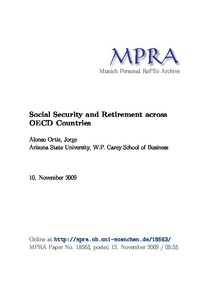Social security and retirement across OECD countries
"There are large differences in the employment to population ratio relative to the US across OECD countries, and these differences are even larger for the old age (55-69 years). There are also large differences in various features of social security, such as the replacement rate, the entitlemen...
| Main Author: | |
|---|---|
| Institution: | ETUI-European Trade Union Institute |
| Format: | TEXT |
| Language: | English |
| Published: |
Munich
2009
MPRA |
| Subjects: | |
| Online Access: | https://www.labourline.org/KENTIKA-19178348124919965209-Social-security-and-retirement.htm |
| Summary: | "There are large differences in the employment to population ratio relative to the US across OECD countries, and these differences are even larger for the old age (55-69 years). There are also large differences in various features of social security, such as the replacement rate, the entitlement age or whether it is allowed to collect social security and working. These observations suggest that they might be an important factor. I assess quantitatively this hypothesis using a life cycle general equilibrium model of retirement. I find that the differences in social security can indeed account for the differences in employment to population ratio at old age in the OECD. I also evaluate which features of social security are most important in this context and find that generosity and whether it allows collecting social security while working are the most important contributors." |
|---|---|
| Physical Description: | 33 p. Digital |

